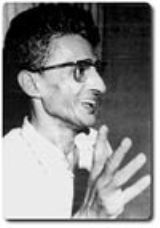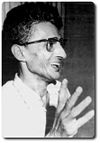
Charu Majumdar
Encyclopedia

Revolutionary
A revolutionary is a person who either actively participates in, or advocates revolution. Also, when used as an adjective, the term revolutionary refers to something that has a major, sudden impact on society or on some aspect of human endeavor.-Definition:...
from India
India
India , officially the Republic of India , is a country in South Asia. It is the seventh-largest country by geographical area, the second-most populous country with over 1.2 billion people, and the most populous democracy in the world...
. Charu Majumdar's life is a story of "riches to rags". Born in a progressive landlord family in Siliguri in 1918, he not only dedicated his entire life to peasants' cause but also authored the historic 1968 Naxalbari uprising, the ideology behind which guides red radicals even
today. He was born in 1918 at Siliguri
Siliguri
Siliguri is a city in the Indian state of West Bengal. It is located in the Siliguri Corridor or Chicken's Neck - a very narrow strip of land linking mainland India to its north-eastern states. It is also the transit point for air, road and rail traffic to the neighbouring countries of Nepal,...
, West Bengal
West Bengal
West Bengal is a state in the eastern region of India and is the nation's fourth-most populous. It is also the seventh-most populous sub-national entity in the world, with over 91 million inhabitants. A major agricultural producer, West Bengal is the sixth-largest contributor to India's GDP...
. His father was a freedom fighter. Majumdar dropped out of college in 1938. In 1946, he joined the Tebhaga movement
Tebhaga movement
The Tebhaga movement was a militant campaign initiated in Bengal by the Kisan Sabha in 1946. At that time share-cropping peasants had to give half of their harvest to the owners of the land...
. He was briefly imprisoned in 1962. He wanted to create a new national homeland Communist Republic of Bangala Rastra.
Dropping out of college in 1937-38 he joined Congress and tried to organise bidi workers. He later crossed over to CPI to work in its peasant front and soon won respect of the poor of Jalpaiguri.
Soon an arrest-warrant forced him to go underground for the first time as a Left activist. Although CPI was banned at the outbreak of World War II, he continued CPI activities among peasants and was made a member of CPI Jalpaiguri district committee in 1942.
The promotion emboldened him to organise a 'seizure of crops' campaign in Jalpaiguri during the Great Famine of 1943, more or less successfully.
In 1946, he joined Tebhaga movement and embarked on a proletariat militant struggle in North Bengal. The stir shaped his vision of a revolutionary struggle. Later he worked among tea garden workers in Darjeeling.
The CPI was banned in 1948 and he spent the next three years in jail. He tied the nuptial knot with a fellow CPI member from Jalpaiguri - Lila Mazumdar Sengupta in January 1954.
The couple shifted to Siliguri, which remained the centre of his activities for a few years. His ailing father and unmarried sister lived there in abject poverty. But even erosion of peasant movement and personal financial crisis did not dampen his revolutionary spirits and he continued efforts to unite labourers, tea garden workers and rickshaw-pullers there.
During the mid 1960s Majumdar organized a leftist faction in Communist Party of India (Marxist)
Communist Party of India (Marxist)
The Communist Party of India is a political party in India. It has a strong presence in the states of Kerala, West Bengal and Tripura. As of 2011, CPI is leading the state government in Tripura. It leads the Left Front coalition of leftist parties in various states and the national parliament of...
(CPI(M)) in northern Bengal. In 1967, a militant peasant uprising took place in Naxalbari
Naxalbari
Naxalbari is the name of a village and a community development block in northern part of the state of West Bengal, India. Naxalbari block comes under the jurisdiction of Siliguri subdivision of Darjeeling district. Naxalbari became famous for the left wing revolt that took place in the late...
, led by the Majumdar group. This group would later become known as the Naxalite
Naxalite
The word Naxal, Naxalite or Naksalvadi is a generic term used to refer to various militant Communist groups operating in different parts of India under different organizational envelopes...
s, and eight articles written by him at this time - known as the Historic Eight Documents
Historic Eight Documents
The Historic Eight Documents are a set of eight monographs authored by the Indian Maoist revolutionary Charu Majumdar that outline the ideological principles on which the Naxalite militant communist movement in India was based...
- have been seen as providing their ideological foundation: arguing that revolution must take the path of armed struggle on the pattern of the Chinese revolution. The same year, Majumdar broke away and formed the All India Coordination Committee of Communist Revolutionaries
All India Coordination Committee of Communist Revolutionaries
All India Coordination Committee of Communist Revolutionaries was formed in 1967 as a pro-People's Republic of China splinter-group of Communist Party of India...
which in 1969 founded the Communist Party of India (Marxist-Leninist)
Communist Party of India (Marxist-Leninist)
The Communist Party of India was formed by the All India Coordination Committee of Communist Revolutionaries at a congress in Calcutta in 1969. The foundation of the party was declared by Kanu Sanyal at a mass-meeting in Calcutta on the 22nd of April .-History:CPI advocated armed revolution and...
—with Majumdar as its General Secretary.
He was captured from his hide-out on July 16, 1972, and killed by police in police custody at the Laal Bazar police Station on July 28, 1972. During his ten days in police custody in Lal Bazar lock-up no one was allowed to see him -- not even his lawyer, family members or a doctor. The Lal Bazar lock-up had achieved a reputation throughout the country for the most horrifying and cruel tortures. He died at 4 am on July 28, 1972 in the same lock-up," the CPI (ML) records say.
"Even the dead body was not given to his family. Police, accompanied with immediate family members carried the body to crematorium... The whole area was cordoned off and no other relatives were allowed in as his body was consigned to flames," CPI (ML) records say.
Though the radical Leftist movement has seen many ideological splits since late 70s, naxalism continues to inspire a number of Leftist groups across the country.
External links
- Link to Charu Majumdar Reference Archive
- Link to Charu Majumdar Reference Archive Link to Charu Majumdar's Life in brief

